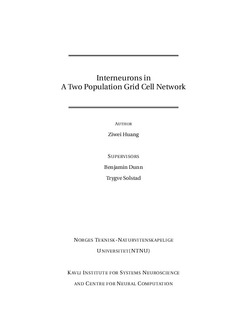Interneurons in a two population grid cell network
Master thesis
Permanent lenke
http://hdl.handle.net/11250/2437083Utgivelsesdato
2015Metadata
Vis full innførselSamlinger
Sammendrag
The hexagonal firing pattern of entorhinal grid cells could arise from a competitive mechanism mediated by interneurons. In this thesis, we asked if a two-population continuous attractor model, consistent with the proposed inhibitory connectivity pattern, could maintain grid cell firing even if interneurons lack spatial periodicity, as was recently observed in a sub-population of entorhinal interneurons.
First, using non-negativematrix factorization,we constructed two-populationmodelswith varying numbers of interneurons while maintaining the same effective connectivity between grid cells. Surprisingly, network drift decreased exponentially with the number of assumed interneurons. Networks having less than 5% interneurons were able to accurately path integrate. The resulting connectivity was patterned with each interneuron receiving projections from either many grid cells with similar spatial selectivity or cells that together formed an inverted grid pattern. In both cases, grid cells with inhomogeneous peak firing rates had lower grid scores than the corresponding interneurons.
Second, we considered a network where the connections from grid cells to interneurons were fixed to sparse random values, while back projections were found using NMF. We found that including variation in the fields of the grid cells resulted in aperiodic neurons in this randomly connected model and the spatial selectivity of interneurons decreased dramatically as the variance in grid field firing rates was increased. Although this network produced aperiodic interneurons similar to recordings, a considerably larger proportion of interneurons was required to reach the same level of stability which did not decrease exponentially as in the fully factorized case.
Furthermore, we analyzed 75 grid cells from a single freely behaving animal and found that the degree to which the firing fields vary was possibly consistent with the models in which gridness score decreased as the grid field variation increased. Take together, our result suggested that the firing patterns of interneurons were not limited to the grid or anti-grid pattern but fell somewhere on the spectrumbetween highly periodic to aperiodic.
